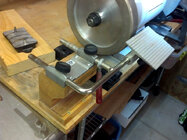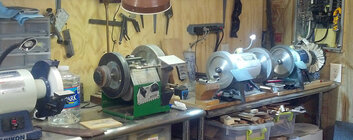I ordered a wolverine sharpening system that with any luck, will be here tomorrow. I’m trying to do a little preemptive planning as to how I want to mount my grinder. My question is this, how far beyond the back of the grinder does the v-arm stick out when it is in use? At almost twenty-eight inches in length, I plan to remove it completely when not in use. Also, any other suggestions on it’s mounting or use would be appreciated as well.
Thank you in advance for any help.
I'm with Dennis. I have four wolverines and cut off most of the end of the v-arm. I think the intended purpose for the long arm 1) can be dangerous in certain situations, and 2), doesn't apply to me anyway since I keep most tools in handles where I can easily remove the tool. I sharpen both skews and roughing gouges by hand on the flat platform. I kept arm one long but never use it.
To use it with the Varigrind for bowl gouges and such only needs maybe a foot or so, didn't measure but I could.
Also, if buying the Varigrind, I have several of the original and bought one of the Varigrind 2 jigs to evaluate. My take: skip the Varigrind 2. Unless I'm missing something, the design seems to be to keep careless people from running the the gouge off the edge of the grinding wheel. This seems fine, but it keeps the tip of the gouge in the center of the wheel and wears it down more there. Besides, in years of using the original Varigrind I have not once let is slip off the edge of the wheel. I use the Varigrind to sharpen bowl gouges.
I like to mount the grinder and the wolverine base on a 3/4" thick square of plywood instead of to a workbench. That lets me move it over or even carry the whole thing somewhere for a demo or instruction. Be advised that some bench grinder base castings are irregular and need a bit of filing or grinding on the bottom.
Another thing, perhaps of only limited use. If your grinder configuration happens to restrict the locking lever handle movement for some reason, the thing can be taken apart and reconfigured so the handle will lock by swinging it the other way.
I did this on one grinder where I had also mounted a Tormek bar so I could use Tormek attachments with the bench grinder on occasion, mostly the gouge jig (not shown here):

My sharpening bench a few years ago, changed somewhat now.

Another thing that really helped me was when I discovered the Wolverine mini platform:
I find this more convenient for some things, especially for tools that are getting short from years of sharpening.
I like the small platforms so much I rarely use the large ones anymore.
JKJ



